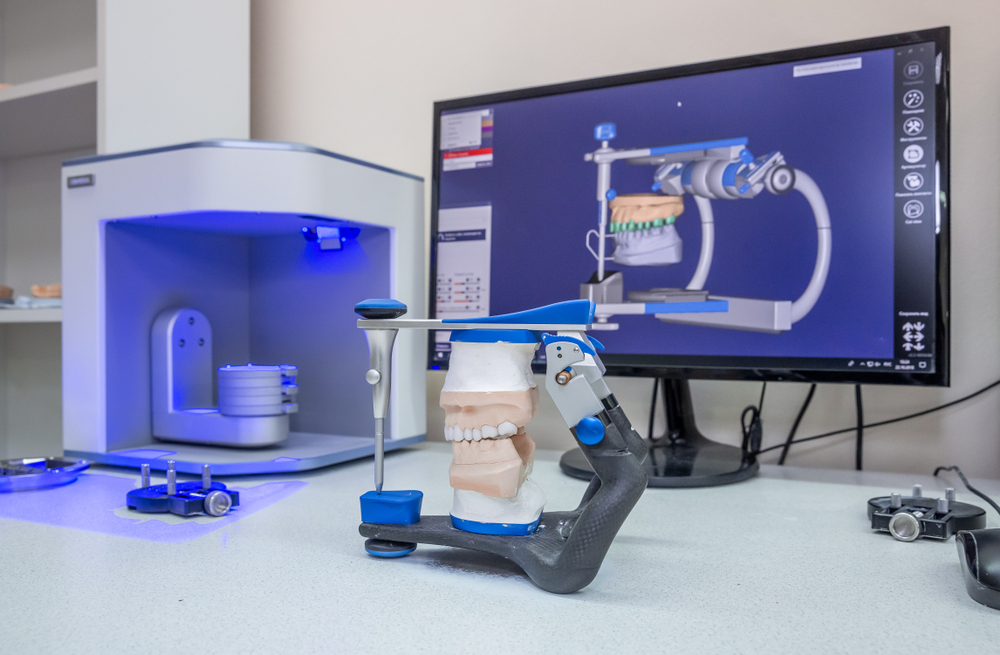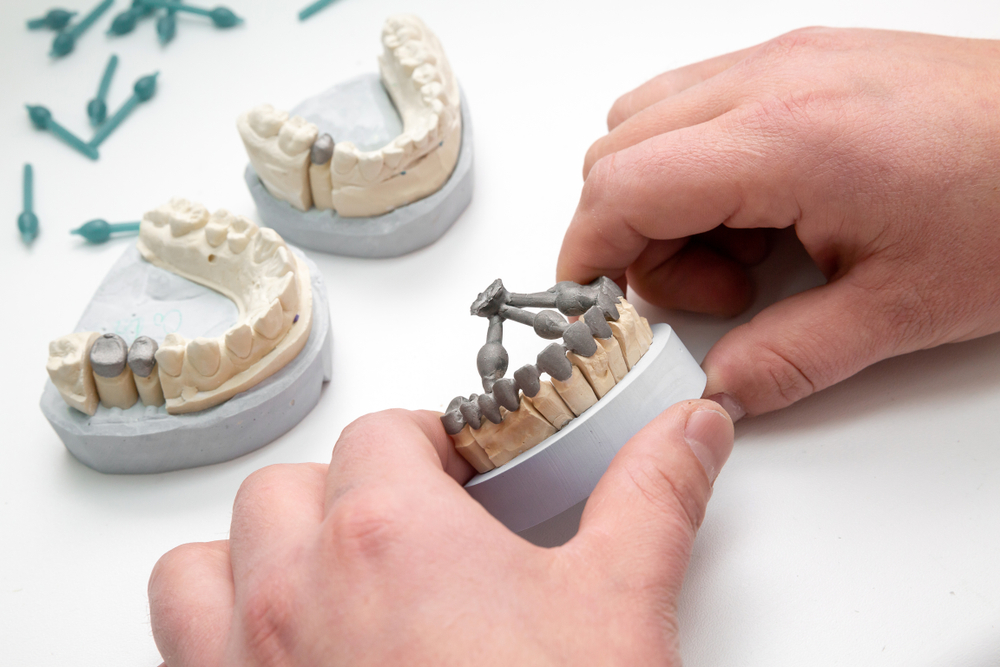With innovations in 3D printing machines and dental resins, there is now a wide range of dental applications for 3D printing. Dental appliances are customized and require manual production, incurring significant costs that are passed onto patients. By providing a flexible and more automated process like 3D printing, dental labs and offices can significantly reduce labor requirements, lower costs, expedite treatment, and provide a better product for patients.
3D printing is unique in its ability to simplify manufacturing by producing numerous same or different products with a digitalized workflow and specialized materials. Today’s printers use advanced resins, software, and hardware to 3D print higher quality dental appliances than traditional manual methods. Dental practitioners and labs that want a flexible production process should consider these applications of 3D printing in dentistry, dental surgery, and orthodontics.

Four 3D Printing Dental Applications to Explore
Dental products require high accuracy and FDA-approved materials. Newer 3D printing dental systems and materials can meet or exceed industry and regulatory standards and requirements, opening up new applications for 3D-printing dental appliances. The four areas below illustrate areas in the dental industry that benefit from 3D printing:
Clear Aligners
One area where 3D printing provides a significant advantage is the direct printing of clear aligners. The traditional thermoforming process, used across multiple products including aligners, retainers, and night guards, requires multiple manual steps and specialized machines to produce clear aligners. Directly 3D printing the final product offers a streamlined process for producing clear aligners and significantly reduces labor requirements. Dental models, thermoforming sheets and forming process, and CNC machining are no longer required. Directly printing the final aligner, only requires a digital model of the patient’s mouth to yield a more accurate and comfortable product. And, if the patient loses it, it takes minutes just to reprint one. In total, 3D-printed clear aligners only involve four steps:
- Practitioners capture an intraoral scan of a patient’s mouth.
- Specialized software translates the scan into digital dental models for each treatment stage.
- Aligner models are generated from the dental models and supports are added.
- The clear aligner directly prints with a dental 3D printer using specialized dental resin.
- The practitioner removes the 3D-printed aligners from the build plate, washes it, and delivers it to the patient.
Directly 3D printing aligners do not require CNC machining, significantly reducing the labor for producing aligners compared to traditionally thermoformed aligners. The process can be integrated into an in-house or outsourced model with fast turnaround times and increased output.
Surgical Guides
3D-printed surgical guides significantly benefit from the high accuracy and flexibility of 3D printing processes. Surgical guides require an accurately placed and oriented bushing in a resin mold, and the mold must have an accurate fit to the patient’s mouth. Advanced 3D printing systems enable a highly accurate production process that provides greater flexibility, dramatically improving the accuracy of the surgery and its success.
Advanced 3D printers for dental appliances fabricate the entire surgical guide in a single printing run and can accommodate multiple holes in various orientations. The bushing hole(s) are directly 3D printed to the exact dimensions and require no post-print reaming to fit the metal bushing. The only other required post-processing steps involve washing and curing the 3D printed guide before use. No further adjustments are needed to ensure a secure fit to the patient’s mouth. Practitioners using 3D printers, software, and materials that are designed to work together in a simple workflow will realize the best results.
Dental Models
The production of dental models traditionally involves a casting process with multiple manual steps. In addition, practitioners must perform grinding and polishing steps to post-process models, requiring skilled manual labor and additional time. Just like clear aligners and surgical guides, 3D printing eliminates manual steps and allows dental professionals to directly produce models from digital scans of a patient’s mouth.

Practitioners directly 3D print models and put them into immediate use for treatment planning and presentation to patients. Advanced 3D printing dental systems produce faster and much more accurate dental models than cast, elevating the precision of treatment plans like denture fitting, surgery planning, and cosmetic dentistry.
Same-day Treatment Products
3D printing does not require skilled and labor-intensive steps to make dental appliances. When combined with advanced 3D printing dental systems that support multiple resin systems developed for specialized applications and material property requirements, dental practitioners and labs can access a single production process that can produce a wide range of dental products. A fully integrated system of printers, specialized software, and advanced resins allows dental professionals to 3D print and deliver many dental products on the same day.
- Faster turnaround: Practitioners can use advanced 3D printing dental systems to directly print clear aligners, surgical guides, dental models, and other products without using an external lab. Designing and printing in-office enables finished products to be provided to patients on the same day. In addition, if patients lose a dental appliance, such as an aligner or retainer, another one can be easily printed and picked up.
- Print in batches: Dental labs can 3D print multiple products in a single print run. Production begins and completes on the same day, and finished products can be quickly delivered to practitioners for patients.
- Less processing and manual labor: Eliminating manual post-processing steps, like grinding and polishing used for thermoformed products, allows faster turnaround time for 3D printed dental products. Reducing time and costs for patients leads to more convenient treatment outcomes.
Use an Integrated 3D Printing System for Dental Products
The best 3D printers for dental applications come with a suite of specialized software for model generation, fast and highly accurate 3D printers, and advanced materials to support the development of new and high-performing products. With its integrated production platform, LuxCreo 3D printing solutions enable dental labs and offices to rapidly produce highly accurate and even better performing dental appliances.
Dental practitioners can 3D print essential treatment products in-office with LuxCreo’s iLux Dental system. For higher volume dental laboratories, there is LuxCreo’s Lux 3D+ dental laboratory platform that supports higher throughput and fully integrated suite of hardware, software, and advanced FDA-approved materials. LuxCreo can help you transform your dental business and create better patient outcomes.
To learn more about our process and systems for 3D printing dental applications, visit our contact page or call (650) 336-0888.
